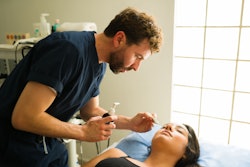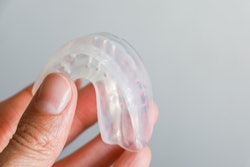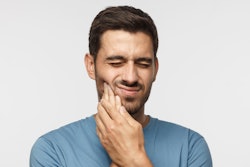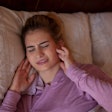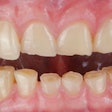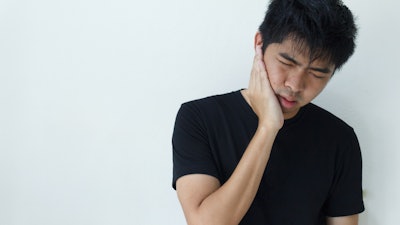
Early joint aspiration or arthrocentesis coupled with the use of a mouthguard may better relieve temporomandibular joint pain (TMJ) from arthritis than only using an occlusal splint. The study was published on June 8 in the International Dental Journal.
At six weeks and after, patients' pain intensity fell significantly in those with TMJ arthralgia who underwent joint aspiration and wore mouthguards. None of the patients experienced serious complications during treatment, the authors wrote.
"Arthrocentesis with occlusal splint support could be discussed as first-line treatment for arthralgia of the TMJ, which may co-occur with various painful and nonpainful conditions of TMJ disorders," wrote the authors, led by Justin Durham of the School of Dental Sciences at Newcastle University in Tyne, U.K.
TMJ pain may be the most critical inducement for patients to seek treatment for temporomandibular joint disorders (TMDs). Arthrocentesis is a minimally invasive procedure that has a success rate of more than 80% and is believed to relieve pain by releasing fibrous adhesions under high pressure and eliminating inflammatory mediators in the synovial fluid of the TMJ.
Despite the potential of arthrocentesis to eliminate arthralgia of the TMJ, many dentists use more conservative treatment approaches, including the use of nonsteroidal anti-inflammatory drugs, physiotherapy, and mouthguards. Though clinicians should not jump to more invasive treatments without trying conservative options, they should not linger too long with traditional approaches if clinical improvement isn't significant, the authors wrote.
To compare the clinical outcomes in the management of TMJ arthralgia treated by early arthrocentesis with occlusal splint support versus mouthguard use alone, a trial included 74 patients. Of these patients, 37 underwent joint aspiration and wore mouthguards, and the other 37 only wore splints. An oral and maxillofacial surgeon performed the two-needle arthrocentesis procedures while patients were under local anesthesia. For the joint aspiration patients, 100 mL of saline and no other substances were injected into their joints, according to the study.
 Arthrocentesis of the TMJ performed in the usual manner under local anesthesia. The puncture point of the inflow needle was at a distance of 10 mm anterior to the tragus and 2 mm inferior to the canthal-tragus line. The puncture point of the outflow needle was at a distance of 20 mm anterior to the tragus and 10 mm inferior to the canthal-tragus line. Image courtesy of Durham et al. Licensed under CC BY-NC-ND.
Arthrocentesis of the TMJ performed in the usual manner under local anesthesia. The puncture point of the inflow needle was at a distance of 10 mm anterior to the tragus and 2 mm inferior to the canthal-tragus line. The puncture point of the outflow needle was at a distance of 20 mm anterior to the tragus and 10 mm inferior to the canthal-tragus line. Image courtesy of Durham et al. Licensed under CC BY-NC-ND.
Both groups were given a flat-plane hard acrylic splint for their upper arches with clasps on the upper first molars to wear nightly. Pain intensity was measured by a numeric rating scale and their progress was followed for one year.
In the patients who underwent joint aspiration, the mean reduction in pain was approximately 76%, an improvement that was considered "substantially important," the authors wrote. In the mouthguard-only cohort, pain reduction was about 49%, which was an improvement deemed "moderately important," they wrote.
Among the patients, none experienced serious adverse effects. Of the patients who underwent joint aspiration, five experienced mild paralysis of the temporal branch of the facial nerve immediately after arthrocentesis but which resolved within four hours postoperatively. Also, 13 of these patients had mild swelling in the preauricular region, but it resolved after three days, they wrote.
Nevertheless, the study had limitations, including that patients were not blind to their assigned treatment groups. This could lead to placebo or bias effect, the authors wrote.
"This randomised controlled trial suggested that early arthrocentesis supported by occlusal splint therapy may be beneficial in the treatment of TMJ arthralgia in terms of better pain control and greater speed of clinical response compared with occlusal splint therapy alone," Durham et al wrote.





